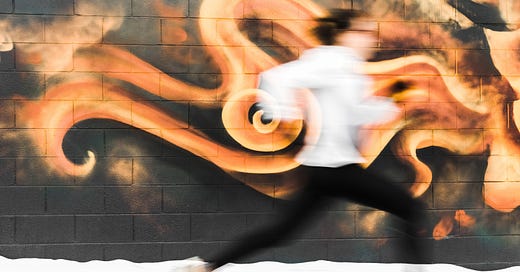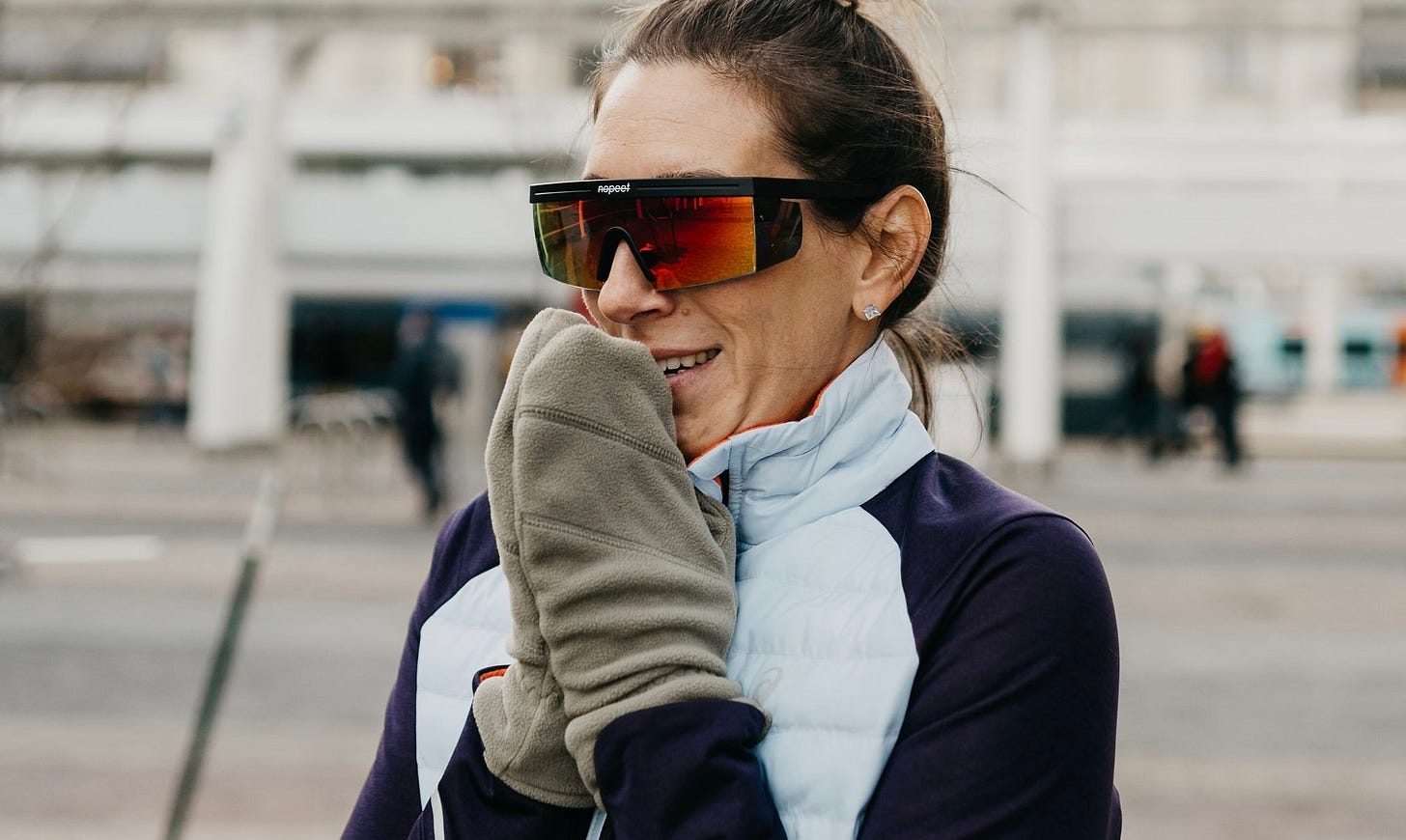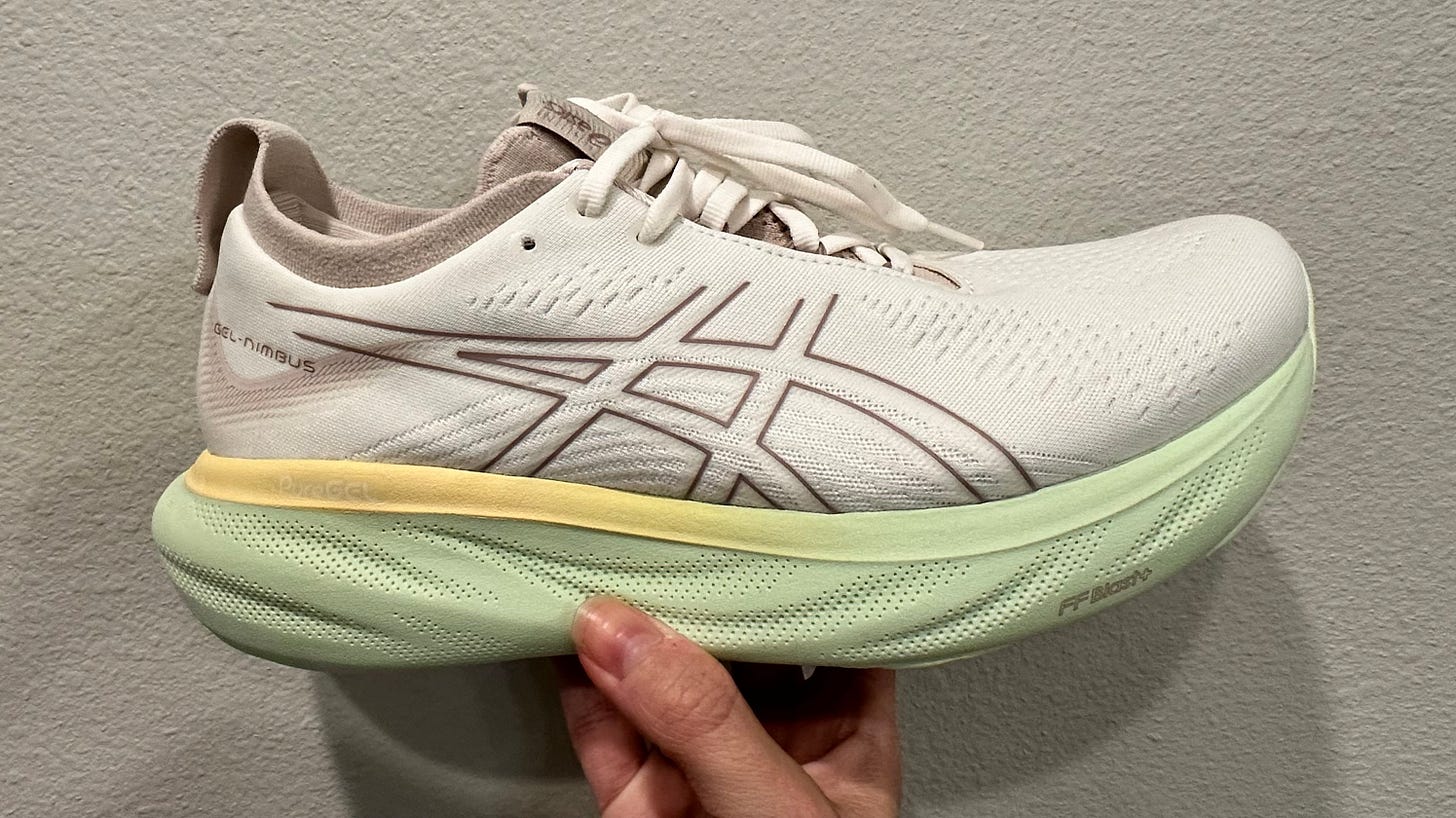Is It Harder to Run In the Winter?
Snow, ice, and frigid temperatures actually have some unexpected benefits.
Running in Denver right now is like navigating the arctic tundra—even with temperatures back above 40 degrees, we’ve got everything from six-inch icebergs littering the roads to sheets of black ice sheathing the sidewalks.
Still, the treadmill is always my last resort. If it’s sunny and over 10 degrees here, I want to be outside. (Although I have my limits—after getting caught in Denver’s “arctic chill” the other week, I accepted a ride from a friend instead of running another 20 minutes home.) And since I’m running an early spring marathon that could be cold, rainy, or who TF knows, I consider the winter elements a kind of mental training.
I get that people hate running outside in the winter, though. With less daylight and highs that rarely crack 50 degrees, it’s hard to find motivation; and when you do manage to get out the door, slippery surfaces and frozen limbs make runs that should be easy feel like a slog.
But…hear me out! There are perks to running in the cold, and it’s not just for sun exposure, your mental health, or because even if you’re freezing at least you feel alive. Running outside through the winter can boost your aerobic performance, make you stronger, and pay off big time when it comes to spring races. Here’s what you need to know.
Is running in the cold harder?
I mean, yes, 100 percent, in my very unscientific opinion. But different people thrive in different conditions. If running does feel harder to you in the cold, that’s totally normal. In moderate temperatures, your body can focus 100 percent on running efficiently; in those conditions, the act of running should feel kind of effortless.
But when the temperature drops, your body has to work harder to keep your vital organs warm. To do that, it shunts blood away from the extremities (which may explain why your hands and toes get so cold) as well as the working muscles, and when your muscles aren’t getting as much oxygen via blood, they can’t work as efficiently. The cold also causes your blood vessels to constrict in order to maintain your core temperature, which further reduces blood flow.
That shouldn’t affect your pace too much, it’s more about how you’ll feel. But if the temperature is below 10°F (with or without the wind chill), that’s when your body may start to feel a little less fluid due to the cold. The United Endurance Sports Coaching Academy recommends slowing your pace by 27 seconds per mile. (The more extreme the temperature change, the more effect it has on your pace). Why? Colder muscles don’t perform as well as warm muscles (ahem, that’s why runners warm up), and aren’t capable of as much explosive power.
How to dress for the cold
When you properly protect yourself against the elements, your body doesn’t have to waste energy staying warm. In general, you should dress for 15° to 20° warmer than the actual temperature; you should be somewhat cold for the first five to 10 minutes, until you start generating body heat. Obviously, the colder the weather, the more layers you should wear: Start with a sweat-wicking base layer, then add on long sleeves, vests, thermal or insulated jackets, or wind jackets, plus a hat and/or gloves, depending on the conditions. (FYI: My hands are always freezing, and the Tracksmith Franklin Mittens are the only gloves that make them actually sweat during runs in sub-zero temperatures.)
As far as shoes go, I’ve mostly been using trail runners on Denver’s roads for extra grip. The North Face Flight VECTIV Guard FUTURELIGHT and La Sportiva Cyklon Cross GTX shoes both have water-repellant integrated gaiters that keep my feet warm and dry, along with heavy-duty lugs that have kept me upright on even my iciest runs (so far). I also like the Nike Zoom Pegasus Turbo Shield, which has a waterproof, gaiter-esque upper but more of a road feel underfoot, as well as the ASICS Novablast 3, which has a stickier grip than most of the road shoes I’ve been using while training for Tokyo.
The benefits of running in the cold
One of the things I’ve actually been enjoying about running Denver’s obstacle course of ice and snow is that it forces me to slow down. The winter is a great time to build volume; since you’re less likely to overheat and it can be downright dangerous to push the pace, you end up clocking more time on feet, which builds your aerobic engine. (I’ve also switched to running mostly by time instead of mileage, which helps when facing the elements.)
And here’s an unexpected benefit of the frigid temps: When air gets colder, it’s molecules become denser and move more slowly. That acts like strength training for your lungs, making them stronger over time and improving your efficiency—which translates to easier efforts at faster paces when the temperatures rise.
Plus, running on uneven surfaces changes your range of motion ever so slightly so you’re engaging different muscles. Think: Your ankles and feet have to work harder on snow and ice to push off the ground; in deeper snow, your hip flexors have to work harder to drive your knees up; and to stay upright in general, you’re calling on smaller stabilizing muscles that aren’t typically needed on a flat, smooth surface. The stronger all your muscles are, the lower your risk of injury and the faster you’ll be when you return to regular road running.
the rundown
Meghann Featherstun on Strength Running
Megann Featherstun, a Registered Dietitian and board certified specialist in sports dietetics (and my #TraintoNYC teammate), was on Jason Fitzgerald’s podcast Strength Running last week talking about all things glucose—a timely topic, considering all the continuous glucose monitors being marketed to runners these days. But it was her comments about fasting pre-run that I think female runners should pay attention to: Mainly, that there’s just no good research to show women should run fasted (unless, maybe/sometimes, an easy run). Also, some people don’t feel hunger cues very well during training. So if you haven’t eaten and you’re feeling anxious, that could be a sign you haven’t eaten enough. Eat a graham cracker pre-run!
“Church of the Long Run,” a Tracksmith Film
Tracksmith recently released a nearly 90-minute video following nurse practitioner and runner Sam Roecker in real time on her Sunday long run in the foothills of Rollinsville, CO. I started watching this on the treadmill, and at first I enjoyed feeling like I was along for the ride. But after 20 minutes of beautiful, cinematic shots of the Colorado scenery, I was craving some kind of story-telling to distract me from the monotony of my own run. It’s well-done from a visual perspective, but I unfortunately lost interest as soon as my own run was over and never went back.
ASICS GEL-Nimbus 25
As much as I love ASICS’ Metaspeed, Superblast, and Novablast, I was never a huge fan of any of their GEL shoes. But I’m super excited about the updated—actually, completely overhauled—GEL-Nimbus 25, which was announced yesterday. I’ve been running in an unbranded version for about a month now and I love all the changes: The stack height is higher, the midsole is similar to that of the Novablast, the outsole is softer, the knit upper is new, and it’s much lighter overall. It’s so plush and cushy, it’s earned a regular spot in my easy run rotation.
Kudos make you run!
Shocking, right? Receiving kudos on Strava motivated runners to run more and more often, a January 2023 study in the journal Social Networks determined. But here’s a twist: Strava “friends” who ran more and more often were not the most influential; athletes’ activities were actually more likely to resemble the running behavior of their Strava “friends” who ran less and less often. It reminded me of an older study that found if you’re using fitness tracking platforms to give support and encouragement to other athletes, that’s great, but if you’re using them for social recognition—i.e. kudos—you’re more likely to develop an obsessive passion for exercise and suffer higher stress levels. So, post with caution.
Good Fit, Slate
Slate recently launched a new column called Good Fit (by Shannon Paulus), and I love that one of the very first articles was “The Case for Slowing Down.” This isn’t a new concept at all (there are entire books around running slower, I’ve written countless articles on it, etc.), but it’s great to see more mainstream outlets a) catering to runners and b) reminding them that it’s not about giving 100% effort 100% of the time. There’s a lot of science packed into this article, so if you’re still skeptical about running slower than feels comfortable during the majority of your workouts, see what the experts have to say.







